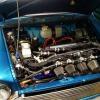The car seems to be willing to come back to life.
I have set the static timing, to 8 degrees BTDC, I connected the coil to the wire coming from the alternator which seems to be giving power non stop, I poured 5l or petrol, sprayed some engine start stuff into the carb and of it went! - for 2 seconds 
The battery is flat, I'm waiting for my friend who will jump start me as my jump starter didn't come back from my family member who I've lent it to.
The good news is that it fired up, and it seems like it will run when I will have some assistance as the previous owners disconnected the choke cable. The bad news is that some hoses coming in/out from the carb are absolutely rubbish and need replacing asap. Another thing is that I can't really identify all the hoses coming into the carb apart from the vacuum hose that will go to the dizzy and the fuel hose coming from the air filter. Maybe my friend will have some other ideas.
One question, what is the metal pipe that runs from below the engine, through the front, behind the grill, above wheel arches and enters the carb into one of the two intakes? The second intake is the fuels hose coming from the filter.
EDIT.
I took a closer look at that hose, it looks like a carb overfill hose, I was wondering why it went from the carb, all the way down underneath the engine, now it makes perfect sense. We also jump started the car, stuck the choke on, put some engine start spray and this time it started up nicely, it did of course have a delayed throttle response and died a couple of times but otherwise it runs smoothly with no rattling or anything. My friend's brother is coming over to his for the weekend and he said he will look at the wires etc. so that I won't have to disconnect the coil to stop the engine. We will also set proper timing for it, see if the carb needs cleaning and all the other bits and bobs that will need sorting.
I guess this thread now deserves to be marked as SOLVED as the engine is running and I see no other brick walls ahead of me so far.
I owe dklawson a massive create of finest beer for his detailed information and time he spent solving my issue. I guess I will be seeing you a lot more often now that the project only begins :)
Thanks again and I will be 'seeing' you around :)
Edited by Oskar, 17 January 2014 - 11:32 PM.



















